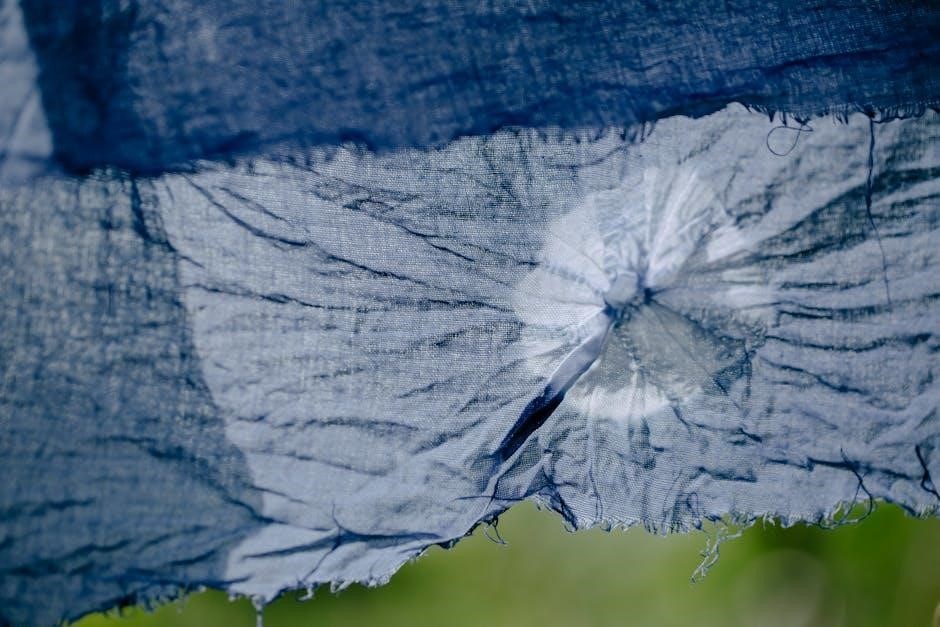
tie and dye techniques pdf
Tie and dye is a resist dyeing method where fabric is tied or folded to prevent dye penetration, creating unique patterns. Originating centuries ago, it is one of the oldest fabric patterning techniques globally, with examples found in ancient Peruvian and Chinese textiles. This craft combines creativity with sustainability, making it accessible for both beginners and experts. Its versatility allows for endless design possibilities, from simple to intricate patterns, using natural or synthetic dyes. Tie and dye techniques have evolved, blending traditional methods with modern innovations, making it a popular choice for DIY projects and artistic expressions. Explore its rich history, cultural significance, and modern applications in our comprehensive guide.
1.1 Definition and History of Tie and Dye
Tie and dye, a resist dyeing technique, involves folding, tying, or binding fabric to prevent dye penetration, creating unique patterns. Originating in ancient India, Japan, Africa, and pre-Columbian Peru, it has been used for centuries to craft vibrant textiles. Early examples include Peruvian alpaca and Chinese silk from the fourth century. This traditional method has evolved, blending natural dyes with modern innovations, preserving its cultural and artistic significance.
1.2 Cultural Significance Across the World
Tie and dye holds deep cultural significance globally, featuring in traditional attire and rituals. In India, it is celebrated in Bandhani designs, while Japan honors Shibori techniques. African communities use vibrant patterns to symbolize identity and heritage. This art form bridges generations, preserving cultural identities while inspiring modern fashion and art. Its universal appeal continues to captivate diverse audiences worldwide.
1.3 Evolution of Tie and Dye in Modern Fashion
Tie and dye has transitioned from traditional craft to mainstream fashion, embraced by designers worldwide. Modern adaptations include bold, abstract patterns and innovative dyeing techniques. The rise of DIY kits and social media has democratized the art, making it accessible to hobbyists and fashion enthusiasts. This timeless technique continues to evolve, blending tradition with contemporary style.
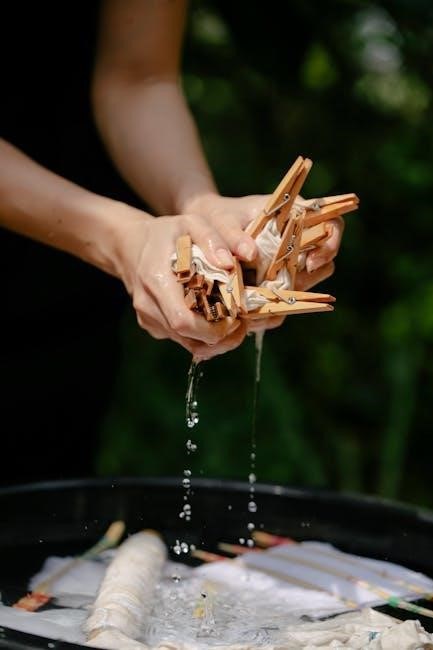
Basic Materials and Tools Required
Natural fabrics, rubber bands, dye powders, soda ash, gloves, buckets, and a heat source are essential. Tools like scissors, measuring cups, and protective gear ensure safe, precise dyeing.
2.1 Fabrics Suitable for Tie and Dye
Natural fibers like cotton, linen, and silk are ideal for tie and dye due to their absorbency. Rayon and bamboo fabrics also work well. Avoid synthetics like polyester, as they resist dye. Pre-wash fabrics to remove finishes that interfere with dye absorption. Natural fibers ensure vibrant, long-lasting colors and are easy to manipulate for unique patterns.
2.2 Types of Dyes and Binders
Natural dyes, like indigo and turmeric, offer earthy tones, while synthetic dyes provide vibrant, colorfast options. Binders such as rubber bands, string, or stitching are used to resist dye penetration. These tools create unique patterns by holding fabric in place during the dyeing process, ensuring distinct color resistance and design variations in tie-and-dye techniques.
2.3 Essential Tools for Binding and Dyeing
Essential tools include rubber bands, strings, and fabric clips for binding, while buckets, gloves, and measuring utensils are vital for dyeing. Protective gear like goggles and aprons ensure safety. Squeeze bottles or sponges help apply dyes precisely, and thermometers monitor temperature for optimal results. These tools collectively enable precise control over the tie-and-dye process, ensuring desired patterns and color outcomes.
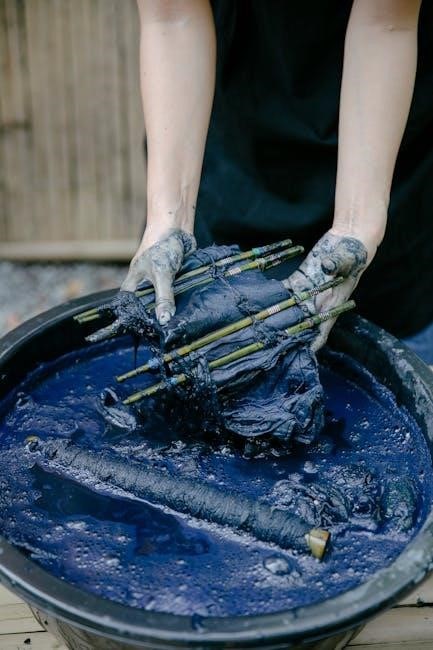
Core Tie and Dye Techniques
Explore fundamental methods like folding, binding, and resist dyeing to create unique patterns. These techniques form the foundation of tie-and-dye artistry, enabling artistic expression through fabric manipulation.
3.1 Folding Methods: Accordion, Spiral, and Pleating
Folding techniques like accordion, spiral, and pleating create unique resist patterns. Accordion folding involves straight, parallel pleats, while spiral folding twists fabric into a circular shape. Pleating creates tight, layered folds. These methods guide dye application, resulting in distinctive designs such as stripes, swirls, or geometric shapes when unfolded.
3.2 Binding Techniques: Knotting, Twisting, and Stitching
Knotting, twisting, and stitching are essential binding techniques in tie and dye. Knotting involves tying fabric into tight knots to create circular resist areas. Twisting entails winding fabric around a core or twisting it into ropes for spiral patterns. Stitching uses thread to sew fabric into shapes, allowing for intricate designs. These methods create distinct resist patterns that guide dye application, resulting in unique, colorful designs when the bindings are removed.
3.3 Resist Dyeing Methods: Shibori and Batik
Shibori and Batik are renowned resist dyeing methods. Shibori involves folding, twisting, or pleating fabric before dyeing to create intricate patterns. Batik uses wax to block dye on specific areas, allowing for detailed designs. Both techniques offer precise control over color placement, resulting in unique, artistic patterns that enhance tie and dye creations with cultural and aesthetic significance.
Step-by-Step Guide to Tie and Dye
Learn to create vibrant patterns by following a structured process: prepare fabric, bind or resist, apply dyes, rinse, and fix colors for lasting results.
4.1 Preparing Fabric for Dyeing
Start by washing and drying fabric to remove finishes. Natural fibers like cotton, linen, silk, and wool work best. Soak fabric in water or soda ash solution for better dye absorption. Iron fabric to remove wrinkles, ensuring smooth folding. Fold fabric into desired patterns like accordion or spiral. Wear gloves and work in a well-ventilated area to ensure safety and protect surfaces from stains.
4.2 Applying Bindings and Resist Methods
Use rubber bands, threads, or clips to create folds and knots, ensuring tight bindings to resist dye penetration. For resist methods, apply wax, starch, or paste to specific areas. Ensure bindings are secure and evenly spaced. Experiment with different techniques like stitching or twisting for unique patterns. Always wear gloves to avoid skin staining during binding processes.
4.3 Mixing and Applying Dyes
Measure dye powders accurately and mix with hot water to achieve desired colors. For cotton, add soda ash to fix dyes. Use squeeze bottles or buckets for application, ensuring even coverage. Follow instructions for natural or synthetic fibers. Allow dyes to set for 6-24 hours before rinsing. Always wear gloves and work in a well-ventilated area for safety.
4.4 Rinsing and Fixing the Dyes
Rinse the fabric gently with cold water to remove excess dye. Wash with mild detergent to fix colors. Soak in vinegar or use a fixative to enhance colorfastness. Allow the fabric to air dry away from direct sunlight. Proper rinsing ensures vibrant, long-lasting results. Always wear gloves and work in a well-ventilated area for safety.
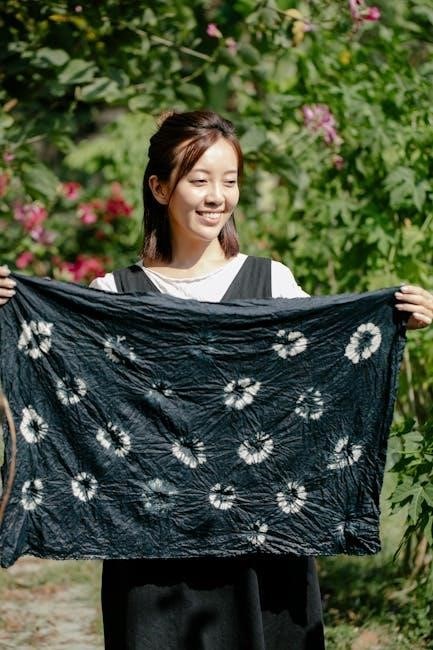
Advanced Tie and Dye Patterns
Explore advanced tie and dye patterns for intricate designs. Fold and bind fabric creatively, layer dyes, and experiment with resist techniques for unique, multi-dimensional effects. Encourage creativity and innovation in every project.
5.1 Creating Multi-Color Designs
Master multi-color tie and dye by layering dyes and using precise binding techniques. Start with a base color, then fold and bind to add contrasting hues. Overdyeing creates depth, while resist methods prevent color bleeding. Use vibrant dyes and plan designs carefully for stunning, multi-tonal patterns. This technique adds complexity and visual interest to fabrics, making each piece unique and eye-catching.
5.2 Layering Techniques for Complex Patterns
Layering techniques involve applying multiple dye layers to create intricate, multi-dimensional designs. Start with a base color, then bind and dye again to add complexity. Each layer builds on the previous one, allowing for detailed patterns. Use folding, twisting, or stitching to isolate areas between layers. This method enables the creation of sophisticated, visually striking designs with depth and texture.
5.3 Incorporating Natural Dyes and Materials
Natural dyes, such as indigo, turmeric, and pomegranate, offer eco-friendly alternatives to synthetic dyes. These materials are sourced from plants and minerals, providing unique, earthy tones. Combine natural dyes with sustainable fabrics like cotton, silk, or hemp for ethical tie-and-dye projects. This approach promotes environmentally friendly practices while creating distinctive, organic patterns with a natural aesthetic and longevity.
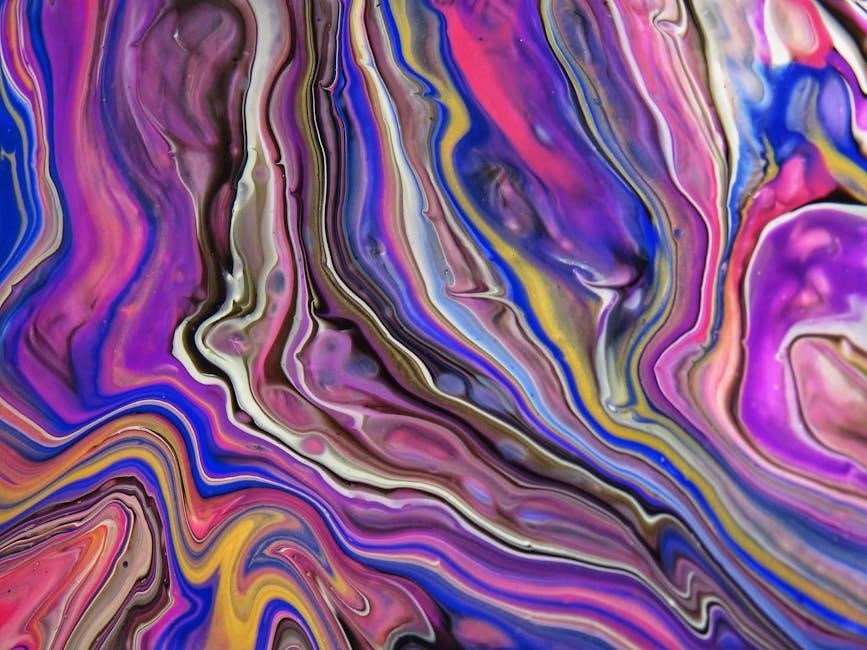
Safety and Best Practices
Always wear gloves and protective eyewear when handling dyes. Ensure good ventilation to avoid inhaling fumes. Follow instructions for dye preparation and disposal to maintain safety and environmental responsibility.
6.1 Safety Precautions When Working with Dyes
Wear protective gloves, masks, and eyewear to avoid skin and eye irritation. Work in a well-ventilated area to prevent inhaling dye fumes. Keep dyes away from children and pets. Handle chemicals carefully, following instructions for proper mixing and disposal. Ensure the workspace is clean and free from flammable materials. Store dyes in sealed containers to maintain safety and organization.
6.2 Environmental Considerations
Opt for natural, biodegradable dyes to minimize ecological impact. Use water wisely and dispose of dye waste responsibly to prevent water pollution. Choose sustainable fabrics like organic cotton. Avoid harmful chemicals and adopt energy-efficient drying methods. Promote eco-friendly practices to ensure tie and dye remains a responsible craft, balancing creativity with environmental stewardship.
6.4 Tips for Achieving Vibrant and Long-Lasting Colors
Use high-quality dyes for better color retention. Pre-soak fabrics in vinegar or soda ash to enhance dye binding. Ensure proper temperature control during dyeing for optimal results. Gently wash dyed fabrics to prevent color bleeding. Fix colors thoroughly to maintain vibrancy over time. Air-dry fabrics to avoid fading from heat. Store tie-dye items away from direct sunlight to preserve hues.
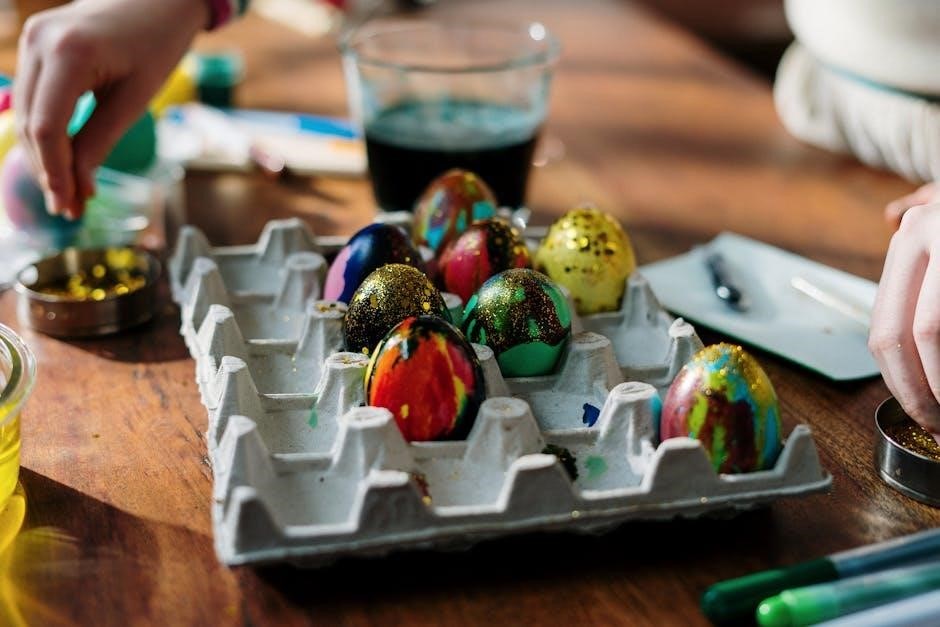
Creative Applications of Tie and Dye
Tie and dye techniques can transform clothing, accessories, and home decor. Experiment with scarves, dresses, and upholstery for unique, personalized designs. This method fosters creativity and sustainability.
7.1 Upcycling Old Clothing
Tie and dye is a fantastic way to upcycle old clothing, giving new life to outdated pieces. By folding, binding, and dyeing, you can create unique, one-of-a-kind designs. This sustainable approach reduces waste and allows you to personalize your wardrobe creatively. It’s a fun and eco-friendly way to refresh your style without buying new clothes and enjoy the satisfaction of creating something truly original.
7.2 DIY Home Decor Projects
Tie and dye can transform plain fabrics into vibrant home decor items. Use techniques to create unique curtains, tablecloths, or pillowcases. This DIY approach allows you to personalize your space with colorful, handmade designs. It’s a creative way to add character to your home while repurposing fabric scraps, making it both eco-friendly and budget-friendly for interior decorating projects.
7.3 Artistic Expressions in Fabric Design
Tie and dye offers endless possibilities for artistic expression in fabric design. Artists can experiment with vibrant colors, intricate patterns, and unique textures. This technique allows for personalization and creativity, making each piece a one-of-a-kind masterpiece. It’s a versatile medium for contemporary art, enabling designers to push boundaries and explore innovative ways to transform fabric into visually striking works of art.
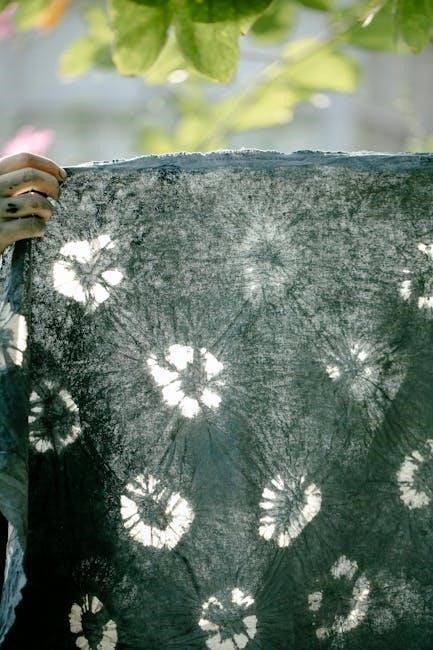
Modern Innovations in Tie and Dye
Modern innovations in tie and dye include the integration of technology, sustainable practices, and hybrid techniques, offering fresh approaches to this ancient craft while maintaining its artistic essence.
8.1 Digital Tools for Design Planning
Digital tools now play a significant role in tie and dye design planning, enabling precise pattern visualization and experimentation. Software like Adobe Illustrator and Photoshop allow artists to create intricate designs digitally before applying them to fabric. Additionally, 3D design tools can simulate dye effects, while apps assist in selecting color palettes and predicting outcomes, enhancing creativity and efficiency in the process.
8.2 Sustainable Practices in Tie and Dye
Sustainable tie and dye practices emphasize eco-friendly materials and methods. Natural dyes, derived from plants, minimize environmental harm. Organic fabrics and non-toxic binders are preferred. Water conservation techniques reduce waste, while repurposing old fabrics promotes circular fashion. These practices not only protect the planet but also yield unique, long-lasting designs that align with ethical fashion principles and consumer demands for greener products.
8.3 Fusion of Traditional and Contemporary Techniques
The fusion of traditional tie and dye with modern techniques creates innovative designs while preserving cultural heritage. Digital tools enable precise pattern planning, while contemporary materials enhance durability. Modern dyers experiment with synthetic dyes for vibrant colors and eco-friendly alternatives. This blend attracts both traditionalists and trend-seekers, ensuring tie and dye remains relevant in today’s dynamic fashion landscape.
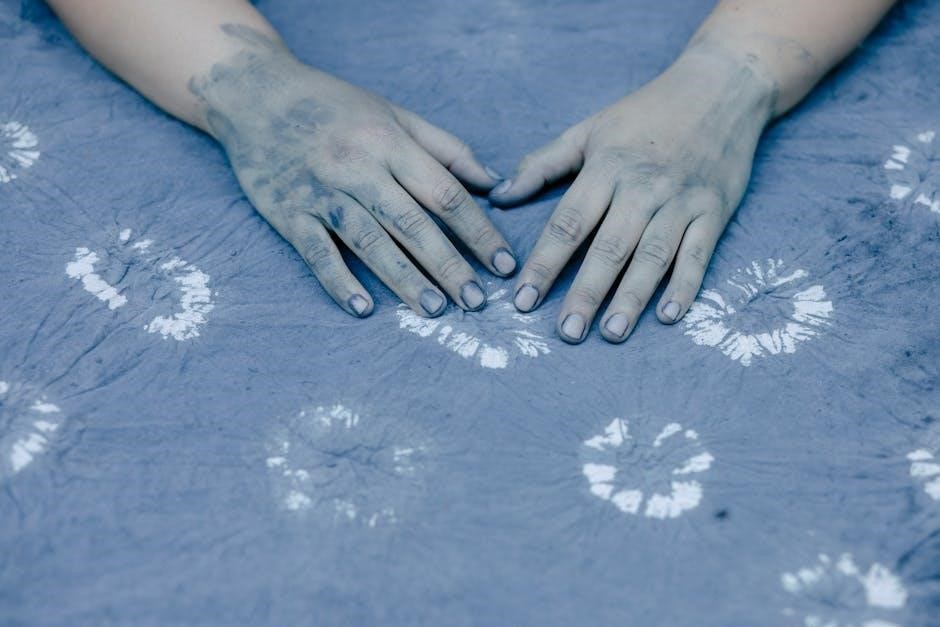
Troubleshooting Common Mistakes
9.1 Preventing Uneven Color Distribution
Ensure even color distribution by properly folding fabric, using sufficient dye, and submerging evenly. Gently agitate and avoid overcrowding to prevent color variation.
To prevent uneven color distribution, ensure proper folding techniques and soak fabric in water mixed with soda ash. Use sufficient dye and fully submerge fabric.
Gently agitate to distribute dye evenly, avoiding overcrowding. Allow fabric to soak longer for consistent results; Avoid sudden movements that might disturb folds, ensuring vibrant, even colors throughout the fabric.
9.2 Fixing Binding Errors
Identify loose knots or uneven folds and tighten or re-tie them before dyeing. Use additional rubber bands or thread to secure fabric properly. Ensure bindings are consistent to achieve desired patterns. Regularly inspect bindings to prevent dye seepage. Applying even pressure during binding helps maintain integrity and avoids color bleed, ensuring crisp, defined designs in the final result.
9.3 Maintaining Fabric Integrity
Prevent fabric damage by using gentle detergents and avoiding hot water. Natural fibers like cotton and silk may require pre-soaking or mordant treatments to protect them during dyeing. Avoid over-binding, as excessive tension can weaken fabric. Handle delicate fabrics with care, and ensure proper rinsing to remove excess dye residue, preserving fabric strength and texture for long-lasting results.
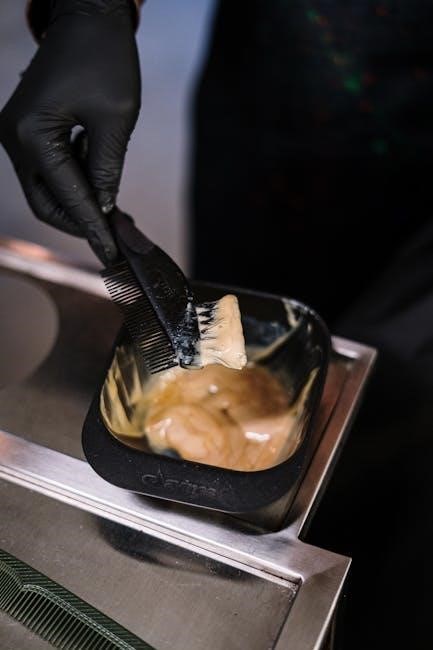
Expert Tips and Tricks
Expert tips include using high-quality dyes, precise folding, and natural materials. Experiment with unique binding techniques and timing for distinctive patterns. Practice makes perfect!
10.1 Achieving Unique Patterns
To achieve unique patterns, experiment with irregular folds and bindings. Use natural materials like leaves or flowers for resist effects. Timing and dye layering create depth. Precision in folding ensures crisp designs, while loose bindings allow for organic, unpredictable results. Combining techniques like shibori and ombre can yield intricate, one-of-a-kind designs that stand out.
10.2 Enhancing Color Vibrancy
To enhance color vibrancy, use high-quality dyes and natural fabrics. Pre-wash fabrics to remove finishes. Soak in hot water before dyeing. Use fixatives to lock colors. Ensure precise dye measurements. Allow fabric to soak longer for deeper penetration. Follow instructions carefully to achieve vivid, long-lasting results.
10.3 Tips for Teaching Tie and Dye to Beginners
Start with simple techniques and demonstrate each step clearly. Use visual aids to explain folding and binding methods. Emphasize safety precautions and proper dye handling. Encourage experimentation with basic patterns. Provide immediate feedback and guidance; Make the process fun and creative, fostering confidence. Offer resources for further learning and practice.
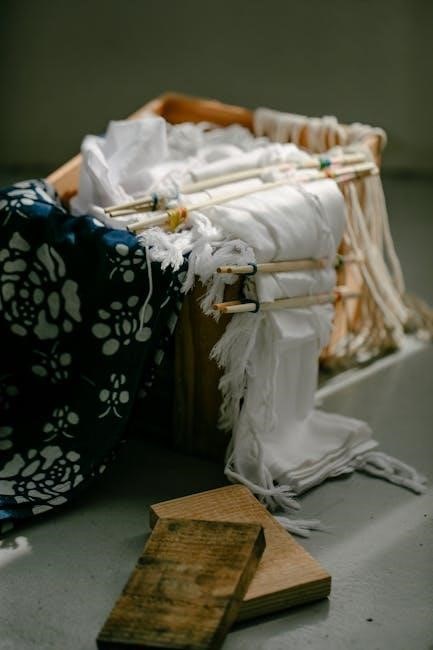
Resources for Further Learning
Explore detailed tie and dye techniques PDF guides, online workshops, and creative communities for in-depth learning and inspiration to master the craft.
11.1 Recommended Tie and Dye PDF Guides
Discover comprehensive tie and dye techniques PDF guides offering step-by-step tutorials, patterns, and creative inspiration. These resources are perfect for beginners and experienced crafters, providing detailed instructions and visual aids to master various methods. Explore crafting websites, online marketplaces, and creative communities to find these invaluable guides, enhancing your skills and exploration of tie-dye artistry.
11.2 Online Tutorials and Workshops
Explore tie and dye techniques through online tutorials and workshops, offering hands-on guidance and expert tips. Platforms like YouTube, Skillshare, and Etsy feature courses taught by skilled artisans. These resources provide interactive learning experiences, helping you refine your skills and explore innovative methods in fabric design and dyeing.
11.3 Communities and Forums for Sharing Ideas
Join online communities and forums dedicated to tie and dye enthusiasts. Platforms like Facebook groups, Reddit forums, and specialized craft communities offer spaces to share ideas, learn from others, and showcase your projects. Engage with fellow artisans, discuss techniques, and gain inspiration for creating unique fabric designs. These networks foster collaboration and creativity.
Tie and dye techniques offer a timeless, versatile, and creative way to transform fabric. Embrace experimentation, push boundaries, and share your unique designs with others. Keep exploring, learning, and inspiring creativity in every stitch and dye.
12.1 Final Thoughts on Tie and Dye
Tie and dye is a vibrant, expressive craft that blends tradition with creativity. Its unique patterns and sustainable nature make it a timeless art form. Whether for fashion or home decor, tie and dye offers endless possibilities. Embrace experimentation, explore natural dyes, and let your imagination flow. The beauty of tie and dye lies in its unpredictability and personal touch.
12.2 Encouraging Creativity and Experimentation
Embrace creativity in tie and dye by experimenting with unique folds, vibrant dyes, and innovative materials. Encourage pushing boundaries, as every mistake can lead to a stunning design. This craft thrives on freedom and unpredictability, making it a perfect outlet for self-expression. Inspire others to explore and enjoy the meditative process of creating one-of-a-kind textiles.